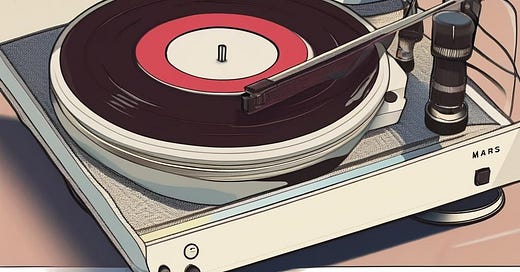I recently bought my son a record player. To accompany this present, I gave him some of my old vinyls. He chose to put on Mike Oldfield’s Tubular Bells. We sat in his room and listened intently to the music.
The first thing that struck me was the music wasn’t as perfect as a digital download. The record had slightly warped over the years in storage. His speakers weren’t as good as my smart phone’s. It sounded slightly tinny. I could hear pops, crackles and hisses as the needle slowly gliding through the grooves on the record.
I realised that unlike a digital download, the record player is more so influenced by the room’s environment. The temperature and the humidity affected the speed of the turntable and how well the pickup moved in the grooves.
At that moment, the analogue felt more real than the digital. It felt warmer than the MP3 version of the song.
Humans are not digital beings. We are not made up of 0s and 1s. We are forged through complex interactions of both biological and metaphysical environments. Could we say ‘we are analogue’?
Whereas digital is made up of discrete values, analogue is a continuous wave. It doesn’t increase or decrease in steps like the digital, but smoothly grows and falls. It mirrors reality more accurately than the digital.
Digital can simulate reality (eg virtual reality), but it lacks the much closer connection to real world, provided by the analogue. Which can more easily reflect the gradual changes in the real environment. This is what analogue technology means, it acts as an analogy to reality, rather than remake it in a digital format.
Digital is very useful and convenient, but it shouldn’t always be preferred to or even replace an analogue solution. Instead, it should be taken on a case by case basis. And I wonder what solutions could be found which combine digital and analogue.
When we are approached with a problem in the business world, our minds tend to automatically leap to find a digital solution. Preferring the latest gadgetry over any tried and tested methods.
Because AngloFuturism is a synthesis of the past and the future, it is unafraid to consider the ‘old hat’ ways of doing things. Especially if it creates more effective solutions. Sometimes an analogue thermometer is better than a digital one in certain circumstances.
There is an apocryphal tale of how NASA were struggling to get a pen to write in zero gravity. After spending millions of dollars, they eventually cracked it. The USSR, on the other hand, simply used a pencil, saving time and money. I don’t know how true this story is, but it illustrates how in some circumstances a less technological solution is preferable. We can draw from this that sometimes an analogue solution is better than a digital one.
I wonder if we allowed space for analogue solutions, then these will likely be more human friendly than the digital alternatives.
AngloFuturism is not anti-technology or a Luddite philosophy. It wants to help integrate the digital realm with the real world, but in a humane way.
This could be encouraged through allowing for analogue solutions. These better reflect the natural world and may help avert an over reliance on the digital. The assumption that the digital is always better, could likely lead to a technological inhumane dystopian future. Even where we will only be known by our digital names, see the film THX-1138.
By opening up the technological space to the analogue, it creates an opportunity for other avenues of development.
So, sometimes a film camera is better. Sometimes an analogue wristwatch is better than a digital one. And sometimes a vinyl LP is better than a digital download.





This reminds me of a rant I once heard against Decimal Currency.
It was on an AA stream a few years ago, ostensibly discussing architecture, but then one of the guests went on a long rant about how Decimal Currency is designed to make your thinking more binary, and in turn exert some control over said thoughts.
I say there's something to this. Pre-1973, you could divide curency into thirds.
For context.
Under Decimal Currency, you have 100p = £1.
You can divide this by 4, 5, 10, 20, 25 and 50.
Before 1973, you had 240d (pence) = £1.
That was 12d=1s (shilling), and 20s = £1.
This opens up the possibility of dividing by 3.